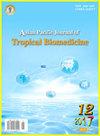非酒精性脂肪肝:流行病学、病理生理学和治疗方法的最新进展
IF 1.7
4区 医学
Q3 TROPICAL MEDICINE
引用次数: 6
摘要
非酒精性脂肪性肝病(NAFLD)是指在没有大量饮酒的个体中出现的一系列脂肪肝疾病。当NAFLD伴有肥胖和2型糖尿病时,它将成为许多国家严重肝脏疾病的最常见病因。它在组织学上进一步分为非酒精性脂肪肝(NAFL;无肝细胞损伤的脂肪变性)和非酒精性脂肪性肝炎(NASH),其特征是肝脂肪变性和炎症共存,并伴有肝细胞损伤(气球样变),伴或不伴纤维化。NAFL被认为是由肝细胞中甘油三酯过度积累引起的良性和可逆阶段。然而,NASH是NAFLD的进展阶段,因为发展成更严重疾病(如肝硬化、肝细胞癌)的风险增加。然而,这一概念最近受到了NAFLD多重平行发作假说的挑战,该假说认为脂肪变性和NASH是独立的实体,而不是NAFLD谱系的两个点,这不仅是从一组组织学模式来看,而且从病理生理角度来看。当前的综述强调了NAFLD的流行病学和病理生理学,以及其向脂肪性肝炎的进展,特别关注了针对NAFLD发生和进展的分子方面和致病途径的新的即将出现的治疗方法。本文章由计算机程序翻译,如有差异,请以英文原文为准。
Non-alcoholic fatty liver disease: Epidemiology, pathophysiology and an update on the therapeutic approaches
Non-alcoholic fatty liver disease (NAFLD) denotes a spectrum of fatty liver disease in individuals without significant alcohol consumption. NAFLD is set to be the most common etiology of serious liver diseases in numerous nations when accompanied by obesity and type 2 diabetes. It is further histologically categorized into the non-alcoholic fatty liver (NAFL; steatosis without hepatocellular injury) and non-alcoholic steatohepatitis (NASH) which is characterized by the coexistence of hepatic steatosis and inflammation and is accompanied by hepatocyte injury (ballooning), either with or without fibrosis. NAFL is considered the benign and reversible stage arising from the excessive accumulation of triglycerides in hepatocytes. However, NASH is a more progressive stage of NAFLD, due to the increased risks of evolving more serious diseases such as cirrhosis, hepatocellular carcinoma. This concept, however, has been lately challenged by a hypothesis of multiple parallel hits of NAFLD, in which steatosis and NASH are separate entities rather than two points of the NAFLD spectrum, not only from a set of histological patterns but also from a pathophysiological perspective. The current review highlights the epidemiology and pathophysiology of NAFLD, and its progression towards steatohepatitis, with special focus on the novel imminent therapeutic approaches targeting the molecular aspects and the pathogenic pathways involved in the development, and progression of NAFLD.
求助全文
通过发布文献求助,成功后即可免费获取论文全文。
去求助
来源期刊

Asian Pacific journal of tropical biomedicine
Biochemistry, Genetics and Molecular Biology-Biochemistry, Genetics and Molecular Biology (miscellaneous)
CiteScore
3.10
自引率
11.80%
发文量
2056
审稿时长
4 weeks
期刊介绍:
The journal will cover technical and clinical studies related to health, ethical and social issues in field of biology, bacteriology, biochemistry, biotechnology, cell biology, environmental biology, microbiology, medical microbiology, pharmacology, physiology, pathology, immunology, virology, toxicology, epidemiology, vaccinology, hematology, histopathology, cytology, genetics and tropical agriculture. Articles with clinical interest and implications will be given preference.
 求助内容:
求助内容: 应助结果提醒方式:
应助结果提醒方式:


